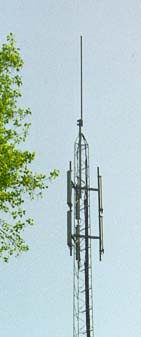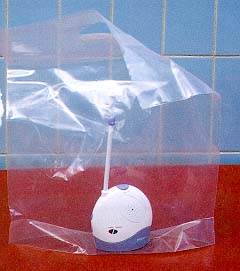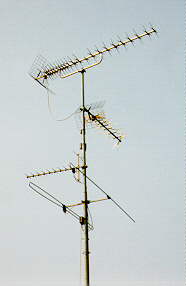

Radio Propagation Models
 Mobile
communication is burdened with particular propagation complications, making
reliable wireless communication more difficult than fixed communication between
and carefully positioned antennas. The antenna height at a mobile terminal is
usually very small, typically less than a few meters. Hence, the antenna is
expected to have very little 'clearance', so obstacles and reflecting surfaces
in the vicinity of the antenna have a substantial influence on the characteristics
of the propagation path. Moreover, the propagation characteristics change from
place to place and, if the terminal moves, from time to time.
Mobile
communication is burdened with particular propagation complications, making
reliable wireless communication more difficult than fixed communication between
and carefully positioned antennas. The antenna height at a mobile terminal is
usually very small, typically less than a few meters. Hence, the antenna is
expected to have very little 'clearance', so obstacles and reflecting surfaces
in the vicinity of the antenna have a substantial influence on the characteristics
of the propagation path. Moreover, the propagation characteristics change from
place to place and, if the terminal moves, from time to time.
Statistical propagation models
In generic system studies, the mobile radio channel is usually evaluated from 'statistical' propagation models: no specific terrain data is considered, and channel parameters are modelled as stochastic variables.
Three mutually independent, multiplicative propagation phenomena can usually be distinguished: multipath fading, shadowing and 'large-scale' path loss.
-
Multipath propagation
Fading leads to rapid fluctuations of the phase and amplitude of the signal if the vehicle moves over a distance in the order of a wave length or more. Multipath fading thus has a 'small-scale' effect.
- Shadowing
This is a 'medium-scale' effect: field strength variations occur if the antenna is displaced over distances larger than a few tens or hundreds of metres.
- Path loss
The 'large-scale' effects cause the received power to vary gradually due to signal attenuation determined by the geometry of the path profile in its entirety. This is in contrast to the local propagation mechanisms, which are determined by terrain features in the immediate vicinity of the antennas.
The large-scale effects determine a power level averaged over an area of tens or hundreds of metres and therefore called the 'area-mean' power. Shadowing introduces additional fluctuations, so the received local-mean power varies around the area-mean. The term 'local-mean' is used to denote the signal level averaged over a few tens of wave lengths, typically 40 wavelengths. This ensures that the rapid fluctuations of the instantaneous received power due to multipath effects are largely removed.
| Radiated power |  | Area-mean power |
 | Local-mean power |
 | Instantaneous power
|
| Attenuation due to Pathloss | | Fluctuations due to Shadowing | | Fluctuations due to Multipath Fading |
|
More pages on propagation

 Detailed discussions
Detailed discussions
- Overview of large-scale propagation models (PS; PDF)
- Statistical Propagation models (PS; PDF)
- Rician and Rayleigh fading
- Statistical behavior of Inphase and Quadrature components (PS; PDF)
- Statistical behavior of amplitude (PS; PDF)
 Data
Bases
Data
Bases
We are building a library of measured reference
channels. We invite propagation researchers to make measurements available
to others. This will allow researchers and designers to make better comparisons
with simulations and system proposals by their collegues. Propagation reseachers
can compare their measurements with work by others. This CD-ROM provides an excellent
opportunity to build such reference library.
 Bibliography
Bibliography
The radio wave propagation slide shows lead you through this topic.
 Exercises
Exercises








 Mobile
communication is burdened with particular propagation complications, making
reliable wireless communication more difficult than fixed communication between
and carefully positioned antennas. The antenna height at a mobile terminal is
usually very small, typically less than a few meters. Hence, the antenna is
expected to have very little 'clearance', so obstacles and reflecting surfaces
in the vicinity of the antenna have a substantial influence on the characteristics
of the propagation path. Moreover, the propagation characteristics change from
place to place and, if the terminal moves, from time to time.
Mobile
communication is burdened with particular propagation complications, making
reliable wireless communication more difficult than fixed communication between
and carefully positioned antennas. The antenna height at a mobile terminal is
usually very small, typically less than a few meters. Hence, the antenna is
expected to have very little 'clearance', so obstacles and reflecting surfaces
in the vicinity of the antenna have a substantial influence on the characteristics
of the propagation path. Moreover, the propagation characteristics change from
place to place and, if the terminal moves, from time to time. 



 Detailed discussions
Detailed discussions Data
Bases
Data
Bases Bibliography
Bibliography Slides
Slides